GBA 231: Living Wills, Ethical Issues & End-of-Life Care Analysis
VerifiedAdded on 2023/06/12
|7
|1674
|137
Report
AI Summary
This report provides a comprehensive analysis of living wills and end-of-life situations, addressing key legal and ethical considerations. It examines the practical necessity of living wills, the implications of active and passive euthanasia, and the importance of addressing social, family, spiritual, and existential needs in end-of-life care. The report also discusses recuperative and palliative care, the right to refuse medical treatment, and the critical distinction between refusing treatment and suicide, referencing the Cruzan v. Director, Missouri Department of Health case. Furthermore, it explores the role of family involvement, ethical practices, and the importance of respecting patient decisions in delivering quality end-of-life care, emphasizing the application of Saint Leo University's core values of community, respect, and integrity in healthcare decisions.
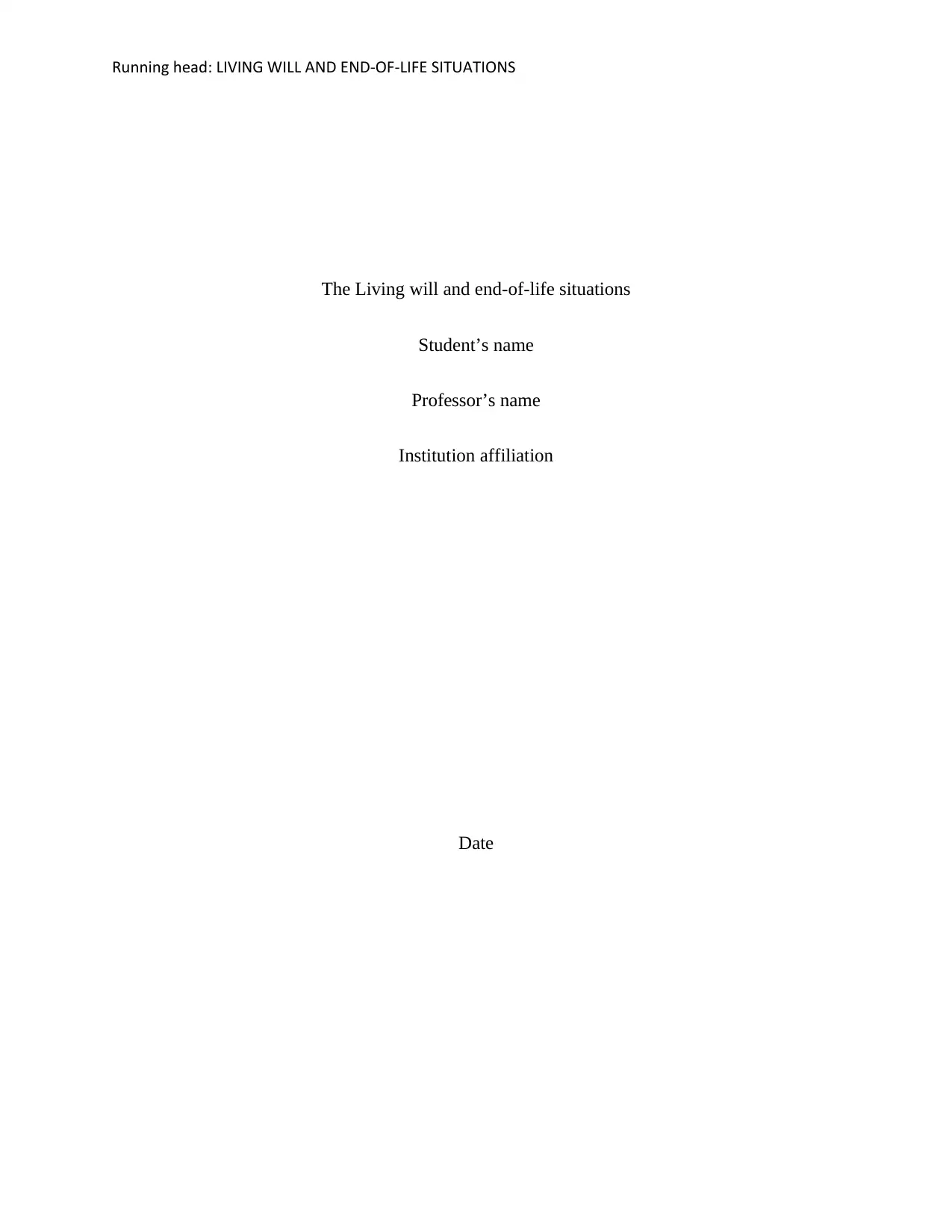
Running head: LIVING WILL AND END-OF-LIFE SITUATIONS
The Living will and end-of-life situations
Student’s name
Professor’s name
Institution affiliation
Date
The Living will and end-of-life situations
Student’s name
Professor’s name
Institution affiliation
Date
Paraphrase This Document
Need a fresh take? Get an instant paraphrase of this document with our AI Paraphraser
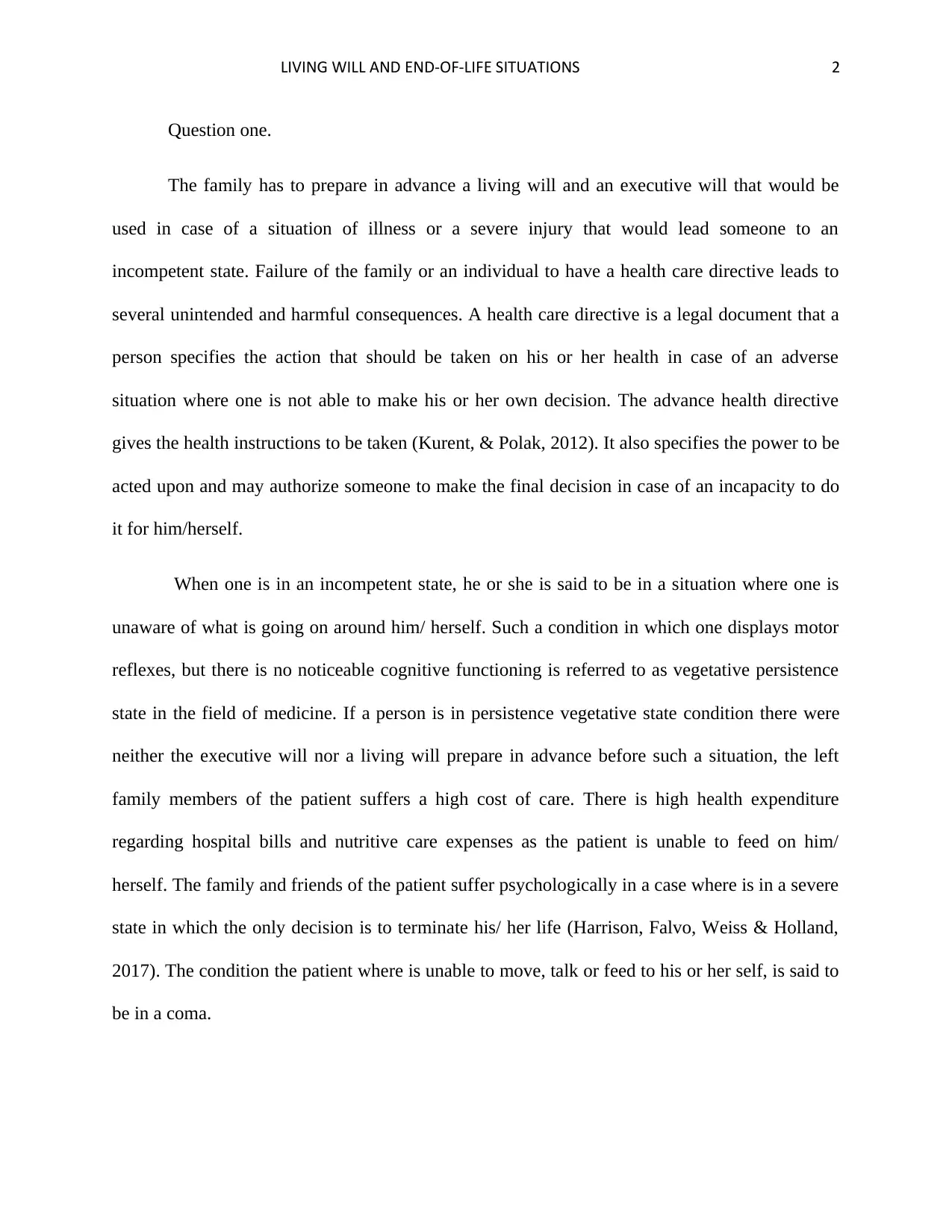
LIVING WILL AND END-OF-LIFE SITUATIONS 2
Question one.
The family has to prepare in advance a living will and an executive will that would be
used in case of a situation of illness or a severe injury that would lead someone to an
incompetent state. Failure of the family or an individual to have a health care directive leads to
several unintended and harmful consequences. A health care directive is a legal document that a
person specifies the action that should be taken on his or her health in case of an adverse
situation where one is not able to make his or her own decision. The advance health directive
gives the health instructions to be taken (Kurent, & Polak, 2012). It also specifies the power to be
acted upon and may authorize someone to make the final decision in case of an incapacity to do
it for him/herself.
When one is in an incompetent state, he or she is said to be in a situation where one is
unaware of what is going on around him/ herself. Such a condition in which one displays motor
reflexes, but there is no noticeable cognitive functioning is referred to as vegetative persistence
state in the field of medicine. If a person is in persistence vegetative state condition there were
neither the executive will nor a living will prepare in advance before such a situation, the left
family members of the patient suffers a high cost of care. There is high health expenditure
regarding hospital bills and nutritive care expenses as the patient is unable to feed on him/
herself. The family and friends of the patient suffer psychologically in a case where is in a severe
state in which the only decision is to terminate his/ her life (Harrison, Falvo, Weiss & Holland,
2017). The condition the patient where is unable to move, talk or feed to his or her self, is said to
be in a coma.
Question one.
The family has to prepare in advance a living will and an executive will that would be
used in case of a situation of illness or a severe injury that would lead someone to an
incompetent state. Failure of the family or an individual to have a health care directive leads to
several unintended and harmful consequences. A health care directive is a legal document that a
person specifies the action that should be taken on his or her health in case of an adverse
situation where one is not able to make his or her own decision. The advance health directive
gives the health instructions to be taken (Kurent, & Polak, 2012). It also specifies the power to be
acted upon and may authorize someone to make the final decision in case of an incapacity to do
it for him/herself.
When one is in an incompetent state, he or she is said to be in a situation where one is
unaware of what is going on around him/ herself. Such a condition in which one displays motor
reflexes, but there is no noticeable cognitive functioning is referred to as vegetative persistence
state in the field of medicine. If a person is in persistence vegetative state condition there were
neither the executive will nor a living will prepare in advance before such a situation, the left
family members of the patient suffers a high cost of care. There is high health expenditure
regarding hospital bills and nutritive care expenses as the patient is unable to feed on him/
herself. The family and friends of the patient suffer psychologically in a case where is in a severe
state in which the only decision is to terminate his/ her life (Harrison, Falvo, Weiss & Holland,
2017). The condition the patient where is unable to move, talk or feed to his or her self, is said to
be in a coma.
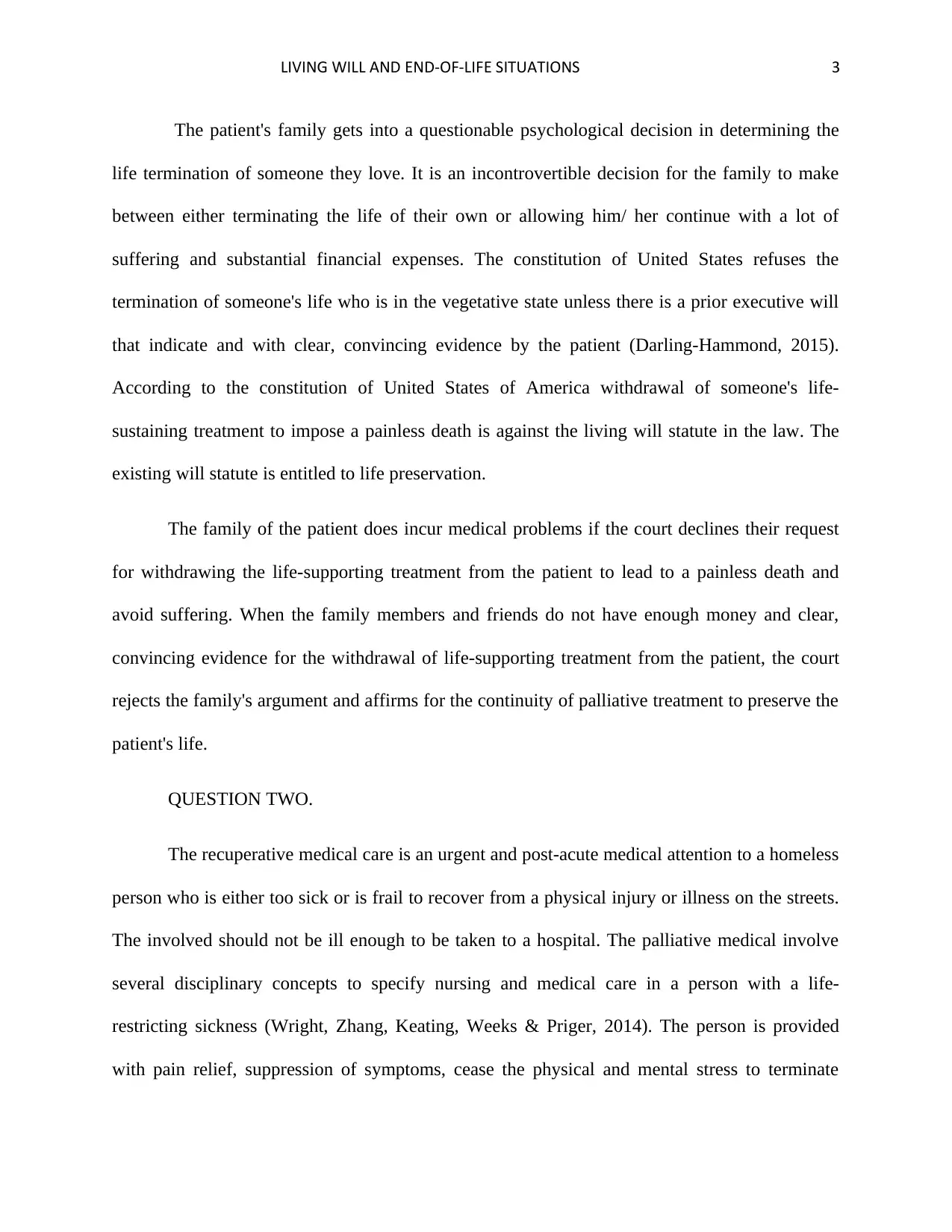
LIVING WILL AND END-OF-LIFE SITUATIONS 3
The patient's family gets into a questionable psychological decision in determining the
life termination of someone they love. It is an incontrovertible decision for the family to make
between either terminating the life of their own or allowing him/ her continue with a lot of
suffering and substantial financial expenses. The constitution of United States refuses the
termination of someone's life who is in the vegetative state unless there is a prior executive will
that indicate and with clear, convincing evidence by the patient (Darling-Hammond, 2015).
According to the constitution of United States of America withdrawal of someone's life-
sustaining treatment to impose a painless death is against the living will statute in the law. The
existing will statute is entitled to life preservation.
The family of the patient does incur medical problems if the court declines their request
for withdrawing the life-supporting treatment from the patient to lead to a painless death and
avoid suffering. When the family members and friends do not have enough money and clear,
convincing evidence for the withdrawal of life-supporting treatment from the patient, the court
rejects the family's argument and affirms for the continuity of palliative treatment to preserve the
patient's life.
QUESTION TWO.
The recuperative medical care is an urgent and post-acute medical attention to a homeless
person who is either too sick or is frail to recover from a physical injury or illness on the streets.
The involved should not be ill enough to be taken to a hospital. The palliative medical involve
several disciplinary concepts to specify nursing and medical care in a person with a life-
restricting sickness (Wright, Zhang, Keating, Weeks & Priger, 2014). The person is provided
with pain relief, suppression of symptoms, cease the physical and mental stress to terminate
The patient's family gets into a questionable psychological decision in determining the
life termination of someone they love. It is an incontrovertible decision for the family to make
between either terminating the life of their own or allowing him/ her continue with a lot of
suffering and substantial financial expenses. The constitution of United States refuses the
termination of someone's life who is in the vegetative state unless there is a prior executive will
that indicate and with clear, convincing evidence by the patient (Darling-Hammond, 2015).
According to the constitution of United States of America withdrawal of someone's life-
sustaining treatment to impose a painless death is against the living will statute in the law. The
existing will statute is entitled to life preservation.
The family of the patient does incur medical problems if the court declines their request
for withdrawing the life-supporting treatment from the patient to lead to a painless death and
avoid suffering. When the family members and friends do not have enough money and clear,
convincing evidence for the withdrawal of life-supporting treatment from the patient, the court
rejects the family's argument and affirms for the continuity of palliative treatment to preserve the
patient's life.
QUESTION TWO.
The recuperative medical care is an urgent and post-acute medical attention to a homeless
person who is either too sick or is frail to recover from a physical injury or illness on the streets.
The involved should not be ill enough to be taken to a hospital. The palliative medical involve
several disciplinary concepts to specify nursing and medical care in a person with a life-
restricting sickness (Wright, Zhang, Keating, Weeks & Priger, 2014). The person is provided
with pain relief, suppression of symptoms, cease the physical and mental stress to terminate
⊘ This is a preview!⊘
Do you want full access?
Subscribe today to unlock all pages.

Trusted by 1+ million students worldwide
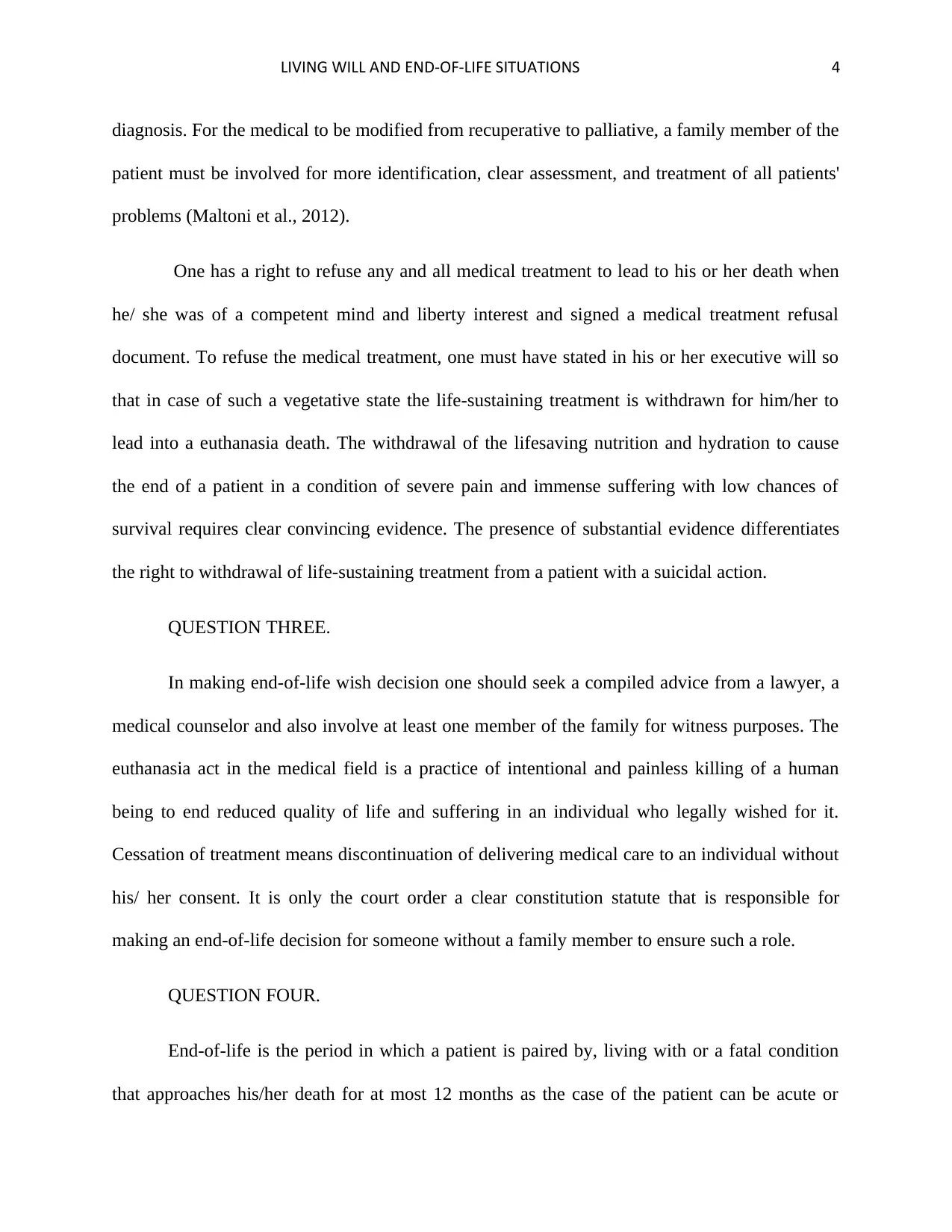
LIVING WILL AND END-OF-LIFE SITUATIONS 4
diagnosis. For the medical to be modified from recuperative to palliative, a family member of the
patient must be involved for more identification, clear assessment, and treatment of all patients'
problems (Maltoni et al., 2012).
One has a right to refuse any and all medical treatment to lead to his or her death when
he/ she was of a competent mind and liberty interest and signed a medical treatment refusal
document. To refuse the medical treatment, one must have stated in his or her executive will so
that in case of such a vegetative state the life-sustaining treatment is withdrawn for him/her to
lead into a euthanasia death. The withdrawal of the lifesaving nutrition and hydration to cause
the end of a patient in a condition of severe pain and immense suffering with low chances of
survival requires clear convincing evidence. The presence of substantial evidence differentiates
the right to withdrawal of life-sustaining treatment from a patient with a suicidal action.
QUESTION THREE.
In making end-of-life wish decision one should seek a compiled advice from a lawyer, a
medical counselor and also involve at least one member of the family for witness purposes. The
euthanasia act in the medical field is a practice of intentional and painless killing of a human
being to end reduced quality of life and suffering in an individual who legally wished for it.
Cessation of treatment means discontinuation of delivering medical care to an individual without
his/ her consent. It is only the court order a clear constitution statute that is responsible for
making an end-of-life decision for someone without a family member to ensure such a role.
QUESTION FOUR.
End-of-life is the period in which a patient is paired by, living with or a fatal condition
that approaches his/her death for at most 12 months as the case of the patient can be acute or
diagnosis. For the medical to be modified from recuperative to palliative, a family member of the
patient must be involved for more identification, clear assessment, and treatment of all patients'
problems (Maltoni et al., 2012).
One has a right to refuse any and all medical treatment to lead to his or her death when
he/ she was of a competent mind and liberty interest and signed a medical treatment refusal
document. To refuse the medical treatment, one must have stated in his or her executive will so
that in case of such a vegetative state the life-sustaining treatment is withdrawn for him/her to
lead into a euthanasia death. The withdrawal of the lifesaving nutrition and hydration to cause
the end of a patient in a condition of severe pain and immense suffering with low chances of
survival requires clear convincing evidence. The presence of substantial evidence differentiates
the right to withdrawal of life-sustaining treatment from a patient with a suicidal action.
QUESTION THREE.
In making end-of-life wish decision one should seek a compiled advice from a lawyer, a
medical counselor and also involve at least one member of the family for witness purposes. The
euthanasia act in the medical field is a practice of intentional and painless killing of a human
being to end reduced quality of life and suffering in an individual who legally wished for it.
Cessation of treatment means discontinuation of delivering medical care to an individual without
his/ her consent. It is only the court order a clear constitution statute that is responsible for
making an end-of-life decision for someone without a family member to ensure such a role.
QUESTION FOUR.
End-of-life is the period in which a patient is paired by, living with or a fatal condition
that approaches his/her death for at most 12 months as the case of the patient can be acute or
Paraphrase This Document
Need a fresh take? Get an instant paraphrase of this document with our AI Paraphraser
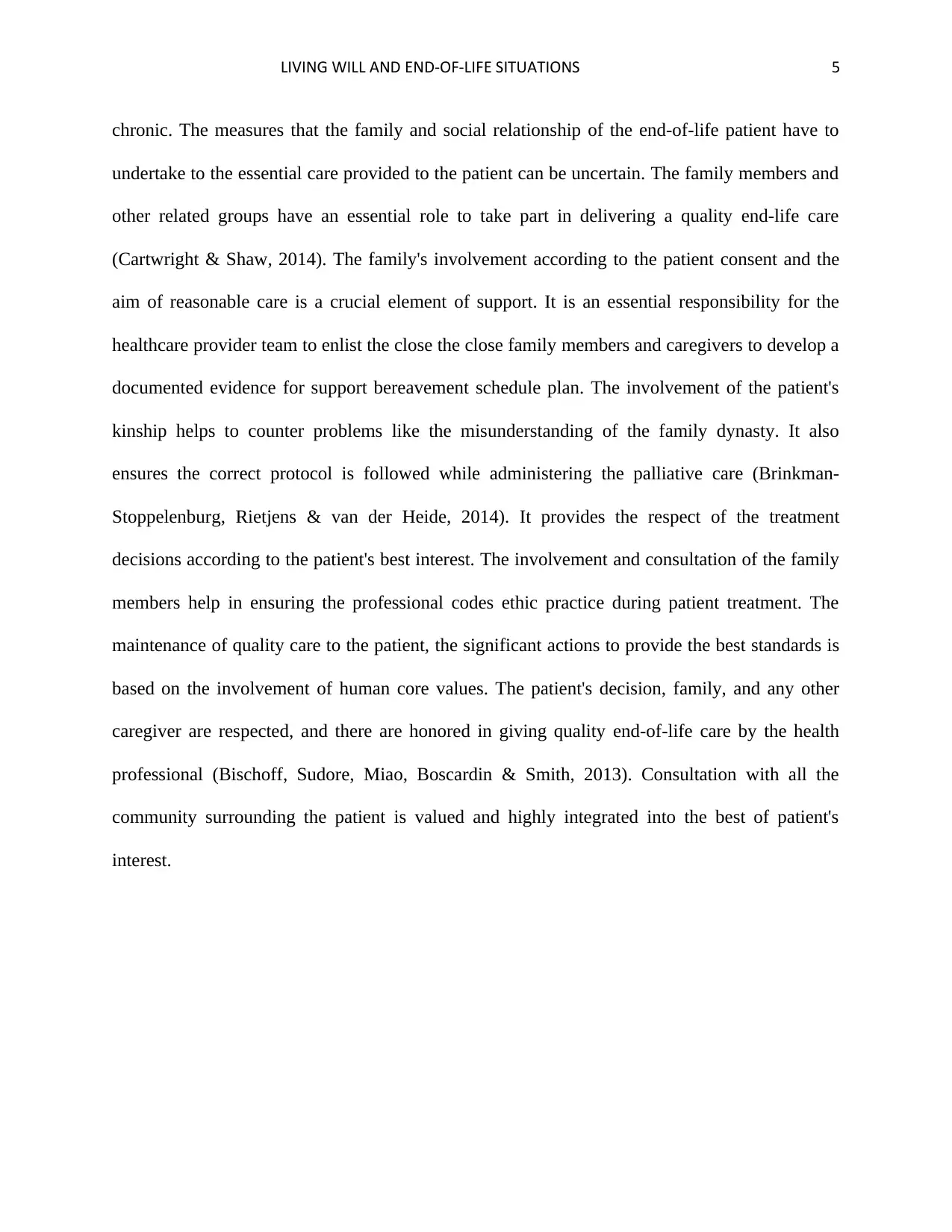
LIVING WILL AND END-OF-LIFE SITUATIONS 5
chronic. The measures that the family and social relationship of the end-of-life patient have to
undertake to the essential care provided to the patient can be uncertain. The family members and
other related groups have an essential role to take part in delivering a quality end-life care
(Cartwright & Shaw, 2014). The family's involvement according to the patient consent and the
aim of reasonable care is a crucial element of support. It is an essential responsibility for the
healthcare provider team to enlist the close the close family members and caregivers to develop a
documented evidence for support bereavement schedule plan. The involvement of the patient's
kinship helps to counter problems like the misunderstanding of the family dynasty. It also
ensures the correct protocol is followed while administering the palliative care (Brinkman-
Stoppelenburg, Rietjens & van der Heide, 2014). It provides the respect of the treatment
decisions according to the patient's best interest. The involvement and consultation of the family
members help in ensuring the professional codes ethic practice during patient treatment. The
maintenance of quality care to the patient, the significant actions to provide the best standards is
based on the involvement of human core values. The patient's decision, family, and any other
caregiver are respected, and there are honored in giving quality end-of-life care by the health
professional (Bischoff, Sudore, Miao, Boscardin & Smith, 2013). Consultation with all the
community surrounding the patient is valued and highly integrated into the best of patient's
interest.
chronic. The measures that the family and social relationship of the end-of-life patient have to
undertake to the essential care provided to the patient can be uncertain. The family members and
other related groups have an essential role to take part in delivering a quality end-life care
(Cartwright & Shaw, 2014). The family's involvement according to the patient consent and the
aim of reasonable care is a crucial element of support. It is an essential responsibility for the
healthcare provider team to enlist the close the close family members and caregivers to develop a
documented evidence for support bereavement schedule plan. The involvement of the patient's
kinship helps to counter problems like the misunderstanding of the family dynasty. It also
ensures the correct protocol is followed while administering the palliative care (Brinkman-
Stoppelenburg, Rietjens & van der Heide, 2014). It provides the respect of the treatment
decisions according to the patient's best interest. The involvement and consultation of the family
members help in ensuring the professional codes ethic practice during patient treatment. The
maintenance of quality care to the patient, the significant actions to provide the best standards is
based on the involvement of human core values. The patient's decision, family, and any other
caregiver are respected, and there are honored in giving quality end-of-life care by the health
professional (Bischoff, Sudore, Miao, Boscardin & Smith, 2013). Consultation with all the
community surrounding the patient is valued and highly integrated into the best of patient's
interest.
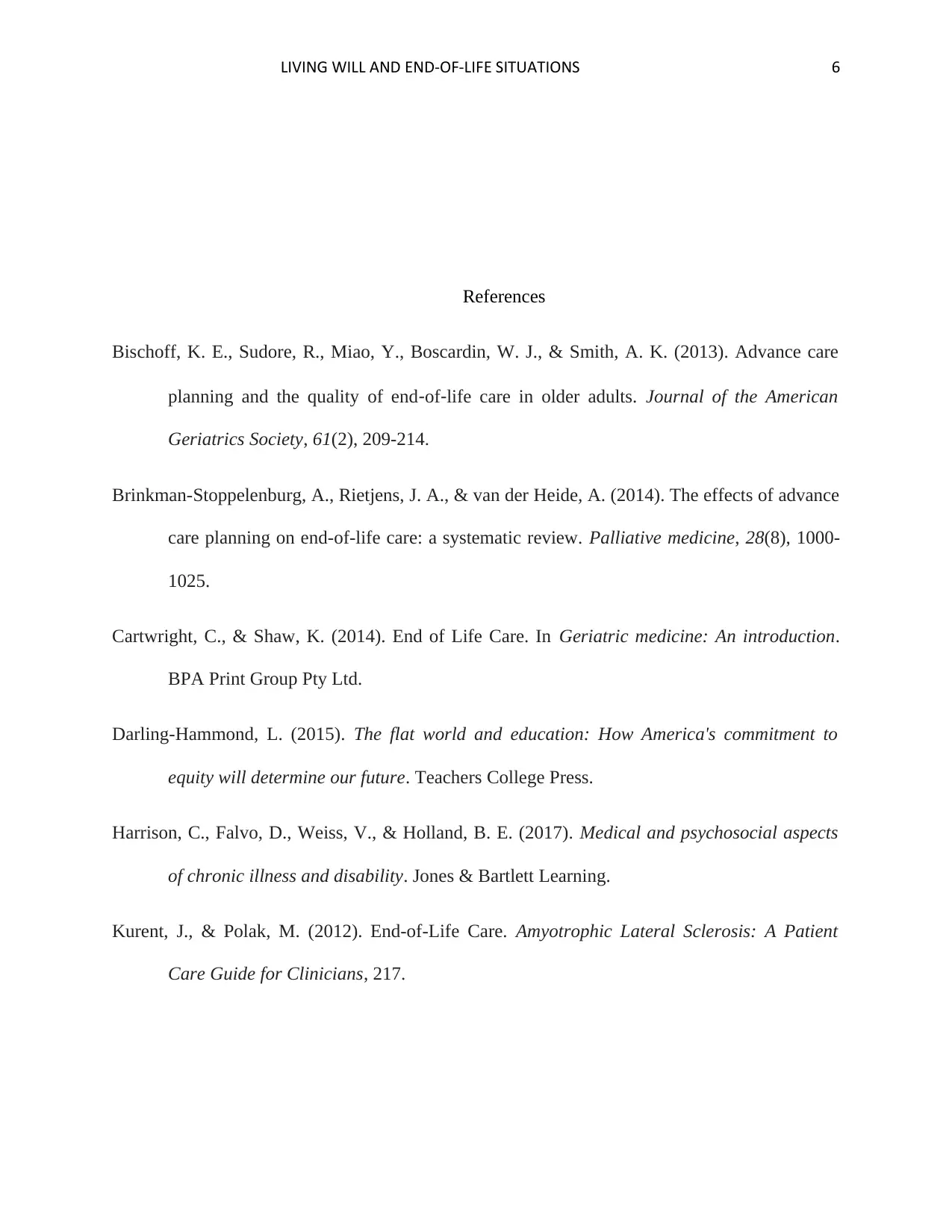
LIVING WILL AND END-OF-LIFE SITUATIONS 6
References
Bischoff, K. E., Sudore, R., Miao, Y., Boscardin, W. J., & Smith, A. K. (2013). Advance care
planning and the quality of end‐of‐life care in older adults. Journal of the American
Geriatrics Society, 61(2), 209-214.
Brinkman-Stoppelenburg, A., Rietjens, J. A., & van der Heide, A. (2014). The effects of advance
care planning on end-of-life care: a systematic review. Palliative medicine, 28(8), 1000-
1025.
Cartwright, C., & Shaw, K. (2014). End of Life Care. In Geriatric medicine: An introduction.
BPA Print Group Pty Ltd.
Darling-Hammond, L. (2015). The flat world and education: How America's commitment to
equity will determine our future. Teachers College Press.
Harrison, C., Falvo, D., Weiss, V., & Holland, B. E. (2017). Medical and psychosocial aspects
of chronic illness and disability. Jones & Bartlett Learning.
Kurent, J., & Polak, M. (2012). End-of-Life Care. Amyotrophic Lateral Sclerosis: A Patient
Care Guide for Clinicians, 217.
References
Bischoff, K. E., Sudore, R., Miao, Y., Boscardin, W. J., & Smith, A. K. (2013). Advance care
planning and the quality of end‐of‐life care in older adults. Journal of the American
Geriatrics Society, 61(2), 209-214.
Brinkman-Stoppelenburg, A., Rietjens, J. A., & van der Heide, A. (2014). The effects of advance
care planning on end-of-life care: a systematic review. Palliative medicine, 28(8), 1000-
1025.
Cartwright, C., & Shaw, K. (2014). End of Life Care. In Geriatric medicine: An introduction.
BPA Print Group Pty Ltd.
Darling-Hammond, L. (2015). The flat world and education: How America's commitment to
equity will determine our future. Teachers College Press.
Harrison, C., Falvo, D., Weiss, V., & Holland, B. E. (2017). Medical and psychosocial aspects
of chronic illness and disability. Jones & Bartlett Learning.
Kurent, J., & Polak, M. (2012). End-of-Life Care. Amyotrophic Lateral Sclerosis: A Patient
Care Guide for Clinicians, 217.
⊘ This is a preview!⊘
Do you want full access?
Subscribe today to unlock all pages.

Trusted by 1+ million students worldwide
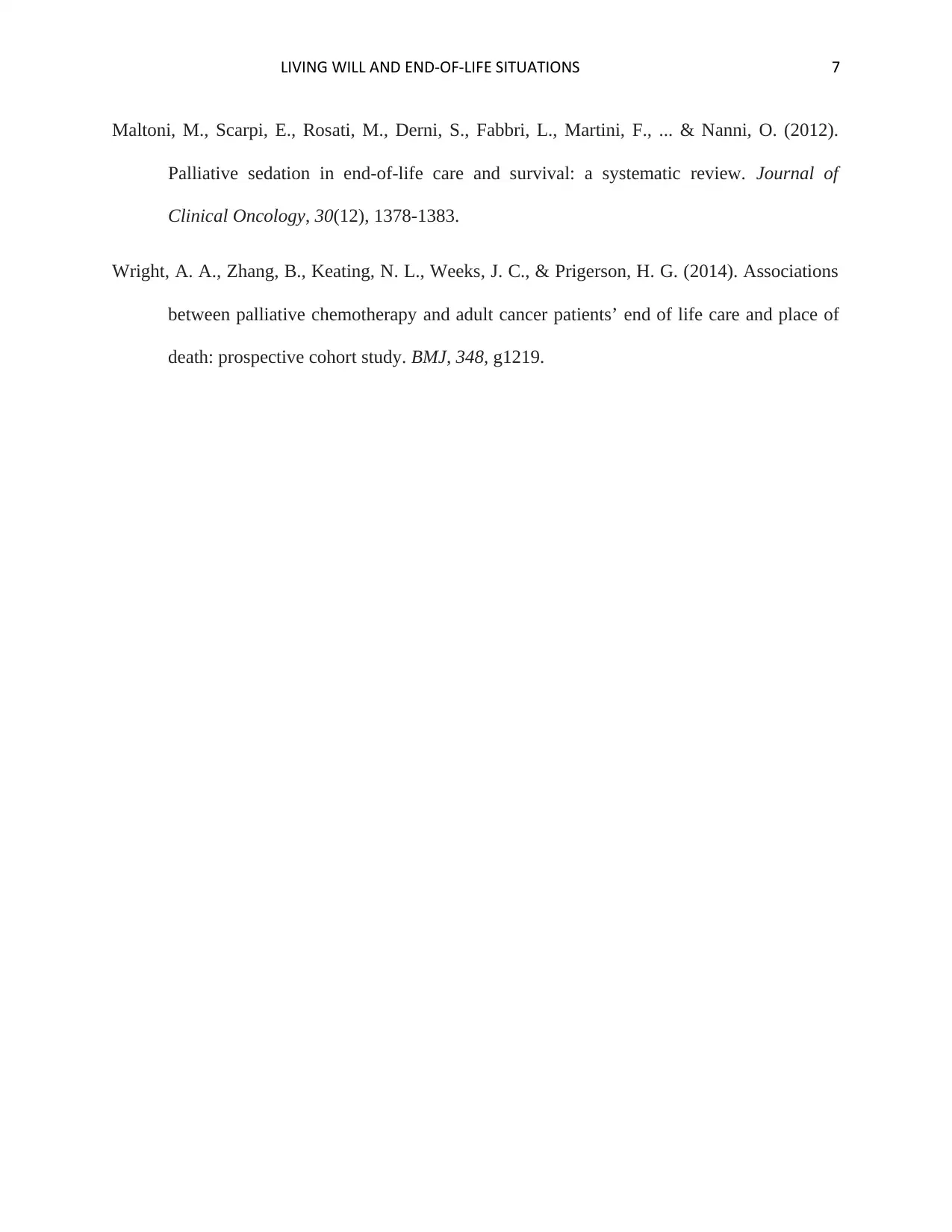
LIVING WILL AND END-OF-LIFE SITUATIONS 7
Maltoni, M., Scarpi, E., Rosati, M., Derni, S., Fabbri, L., Martini, F., ... & Nanni, O. (2012).
Palliative sedation in end-of-life care and survival: a systematic review. Journal of
Clinical Oncology, 30(12), 1378-1383.
Wright, A. A., Zhang, B., Keating, N. L., Weeks, J. C., & Prigerson, H. G. (2014). Associations
between palliative chemotherapy and adult cancer patients’ end of life care and place of
death: prospective cohort study. BMJ, 348, g1219.
Maltoni, M., Scarpi, E., Rosati, M., Derni, S., Fabbri, L., Martini, F., ... & Nanni, O. (2012).
Palliative sedation in end-of-life care and survival: a systematic review. Journal of
Clinical Oncology, 30(12), 1378-1383.
Wright, A. A., Zhang, B., Keating, N. L., Weeks, J. C., & Prigerson, H. G. (2014). Associations
between palliative chemotherapy and adult cancer patients’ end of life care and place of
death: prospective cohort study. BMJ, 348, g1219.
1 out of 7
Related Documents
Your All-in-One AI-Powered Toolkit for Academic Success.
+13062052269
info@desklib.com
Available 24*7 on WhatsApp / Email
![[object Object]](/_next/static/media/star-bottom.7253800d.svg)
Unlock your academic potential
Copyright © 2020–2025 A2Z Services. All Rights Reserved. Developed and managed by ZUCOL.




